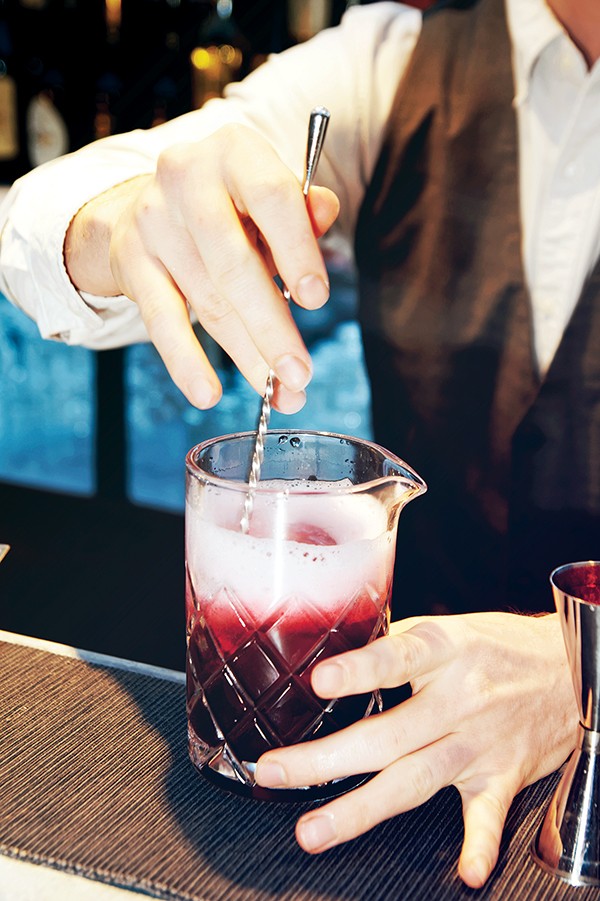Cocktail shrubs, or homemade drinking vinegars, have been around on these shores since the Colonial era, when, during fall harvest, fruits and berries were preserved in apple cider vinegar for use during the winter months. The practice, which has its roots in 17th-century England, evolved over the next 200 years until recipes looked much as they do today: Pour a bit of cider vinegar over some fruit, herbs, or berries to infuse for several days; strain the fruit and add honey to sweeten; then use the resulting concoction (named as a variation of the Arabic word sharab, which means “to drink”) as a cocktail mixer.
Shrubs flourished during America’s first 150 years, thanks in large part to apple cider vinegar’s reputation as a formidable home remedy, then fell out of favor once refrigeration became de rigueur at the turn of the 20th century.
Today, as part of the still-flourishing farm-to-table movement and spinoff hobbies like home canning, beekeeping, and backyard chicken farming, cocktail shrubs are having a moment.
Locally, I’ve seen them on the menu at Loflin Yard, where pineapple shrub is an integral ingredient in the rum- and cardamom-flavored There’s a Baby Hippo at the Zoo. McEwen’s offers a vodka-based pear and thyme shrub cocktail, while Felicia Suzanne’s will pair bourbon, vodka, gin, rum, or tequila with their rotating menu of house-made fruit shrubs and a splash of club soda.
At home, cocktail shrubs can add an enormous flavor impact on a very low calorie count.
 Fedor Kondratenko | Dreamstime
Fedor Kondratenko | Dreamstime
Last time I placed an Amazon order, I added a few bottles of Calvit’s Shrubs, a boutique Minneapolis brand, to my online shopping cart. Online options run the gamut from variety packs to 16-ounce bottles that can be used to flavor non-alcoholic drinks or boozy cocktails. I chose the Beet/Ginger drinking shrubs with Szechuan pepper and the Tomatillo/Tamarind drinking shrubs with hibiscus flowers. Both flavors are made from real fruits and vegetables, packing a lean 35 calories per ounce.
This weekend, I opened both bottles for a taste test. Each looked appealingly healthy in that chic craft farm kind of way; neither tasted great on its own, due to their main ingredient, apple cider vinegar. When I combined an ounce of each with an ounce of vodka, and topped the glass off with club soda, magic happened.
The Beet/Ginger cocktail boasted a deep red color. It tasted tangy, earthy, and peppery — all at once, tingling my nose as it went down. The Tomatillo/Tamarind cocktail was a paler pink. It tasted a little more complex and slightly sour — but not in a bad way. Sipping it, I felt as if I was drinking a robust health tonic rather than a Saturday night cocktail. It was a sensation I appreciated so much that I drank two in a row.
Calvit’s represents just the tip of the iceberg online, where you can also find cocktail shrubs in the following flavors: peach habanero and apple ginger (both from Twisted Shrub, which also hails from Minneapolis); cranberry (from the Michigan-based McClary Bros. brand); and Asian pear (from Californian brand Crafted Cocktails).
You can also make your own cocktail shrubs while spending a minimum amount of time in the kitchen. The simplest recipe calls for two cups of fresh or frozen fruit and two cups of apple cider vinegar. Combine both in a large screw-top jar, shake for 10 seconds, then place in a dark pantry for a week, shaking daily. Strain the liquid through a double-layer of cheesecloth and funnel into a clean jar, adding
1 ½ cups sugar and shaking to combine. Store the jar in the refrigerator for one more week, shaking daily until the sugar has fully dissolved. Experiment with fruits, vegetables, berries, and sweeteners.